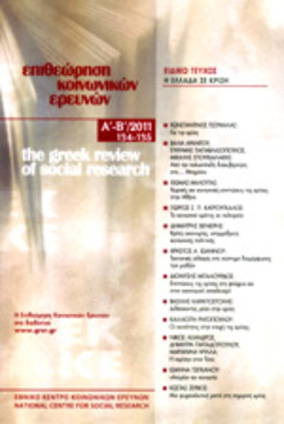H κοινωνική αναπαράσταση του βιώσιμου σχεδιασμού στους έλληνες αρχιτέκτονες
Part of : Επιθεώρηση κοινωνικών ερευνών ; Vol.142, 2014, pages 71-100
Issue:
Pages:
71-100
Parallel Title:
Greek architects' social representation of sustainable design
Section Title:
Articles
Author:
Abstract:
The centrality of sustainable design in architectural thought today and the polysemy of its content raise questions regarding its perception by architects. Based on the interpretative pluralism of sustainable design observed in architectural knowledge and practice, the study aims at understanding architects discourses on sustainable design in the light of the theory of social representations. Drawing on the findings of in-depth interviews with Greek architects, the features of the representation of sustainable design - which differentiate sustainable design from what is perceived as unsustainable design - as well as the mechanisms that describe its emergence, unfold.
Subject:
Subject (LC):
Keywords:
sustainability, design, social representations, architects, βιωσιμότητα, σχεδιασμός, κοινωνικές αναπαραστάσεις, αρχιτέκτονες
Electronic Resources:
References (1):
- Barlett P.F. (ed.), 2005, Urban place: reconnecting with the natural world, Massachusetts, MIT Press. Bauer M.W., 2000, «Classical content analysis: a review», in Bauer M.W. and Gaskell G. (eds), Qualitative researching with text, image and sound: a qualitative handbook, London, Sage. Bauer M. W. and Gaskell G., 1999, «Towards a paradigm for research on social representations, Journal for the Theory of Social Behaviour, 29 (2), pp. 163-186. Bauer M. W. and Gaskell G., 2008, «Social representations theory: a progressive research programme for social psychology», Journal for the Theory of Social Behaviour, 38 (4), pp. 335-353. Brand S., 1994, How buildings learn: what happens after they’re built, N.Y., Penguin. Brown G.Z. and DeKay M., 2000, Sun, wind and light: architectural design strategies, 2nd Edition, New Jersey, John Wiley & Sons. Campbell S., 1996, «Green cities, growing cities, just cities: urban planning and the contradictions of sustainable development», Journal of the American Planning Association, 62 (3), pp. 296-312. Duveen G., 2001, «Introduction: the power of ideas», in Moscovici S., Social representations: Explorations in Social Psychology, NY, New York University Press. Farr D., 2007, Sustainable urbanism: urban design with nature, New Jersey, John Wiley & Sons. Fry T., 1999, A new design philosophy: an introduction to defuturing, Sidney, UNSW Press. Gaskell G., 2000, «Individual and group interviewing», in Bauer M.W. and Gaskell G. (eds), Qualitative researching with text, image and sound: a qualitative handbook, London, Sage. Glaser B. and Strauss A., 1967, The discovery of grounded theory, Chicago, Aldine. Gibbons M., Limoges C., Nowotny H., Schwartzman S., Scott P., & Trow M., 1994, The new production of knowledge: the dynamics of science and research in contemporary societies, London, Sage. Gordon H., 2000, «Sustainable Design Goes Mainstream», in Brown D.E., Fox M., and Pelletier M.R. (eds), Sustainable architecture: white papers, New York, Earth Pledge Foundation. Gutman R., 1988, Architectural practice: a critical view, Princeton, Princeton Architectural Press. Guy S., 2009, «Fluid architectures: ecologies of hybrid urbanism», in White D.F. and Wilbert C. (eds), Technonatures: environments, technologies, spaces and places in the twenty-first century, Waterloo, Wilfrid Laurier University Press. Guy S., 2012, «Introduction: whither ‘‘earthly’’ architectures: constructing sustainability», in Crysler C., Cairns S. and Heynen H. (eds), The SAGE handbook of architectural theory, London, Sage Publications Ltd. Guy S. and Moore S. A., 2005, «The paradoxes of sustainable architecture», in Guy S. and Moore S.A. (eds), Sustainable architectures: cultures and natures in Europe and North America. N.Y., London., Spon Press. Jamison A., 1995, «The making of Lewis Mumford’s technics and civilization», European Society for the Study of Science and Technology (EASST) Review, 14 (1). Available at http:// www.easst.net/review/march1995/jamison Jamison A., 2001, The making of green knowledge, Cambridge, Cambridge University Press. Jamison A., 2012, «Turning engineering green: sustainable development and engineering education», in Christensen S. H., Mitcham C., Bocong L., and An Y. (eds), Engineering, development and philosophy: American, Chinese, and European perspectives, London, Springer. Jänicke Μ., 1985, Preventative environmental policy as ecological modernisation and structural policy, paper 85/2, Berlin, Wissenschaftszentrum. Kwok A.G and Grondzik W.T., 2007, The green studio handbook: environmental strategies for schematic design, MA, Elsevier. Levins A. and Silver C., 2007, Using software in qualitative research. A step-by-step guide, London, Sage. Moscovici S., 2001, Social representations: explorations in social psychology, NY, New York University Press. Picon A, 2003, «Architecture, science, technology and the virtual realm», in Picon A. and Ponte A. (eds), Architecture and the sciences: exchanging metaphors, NY, Princeton Architectural Press.




